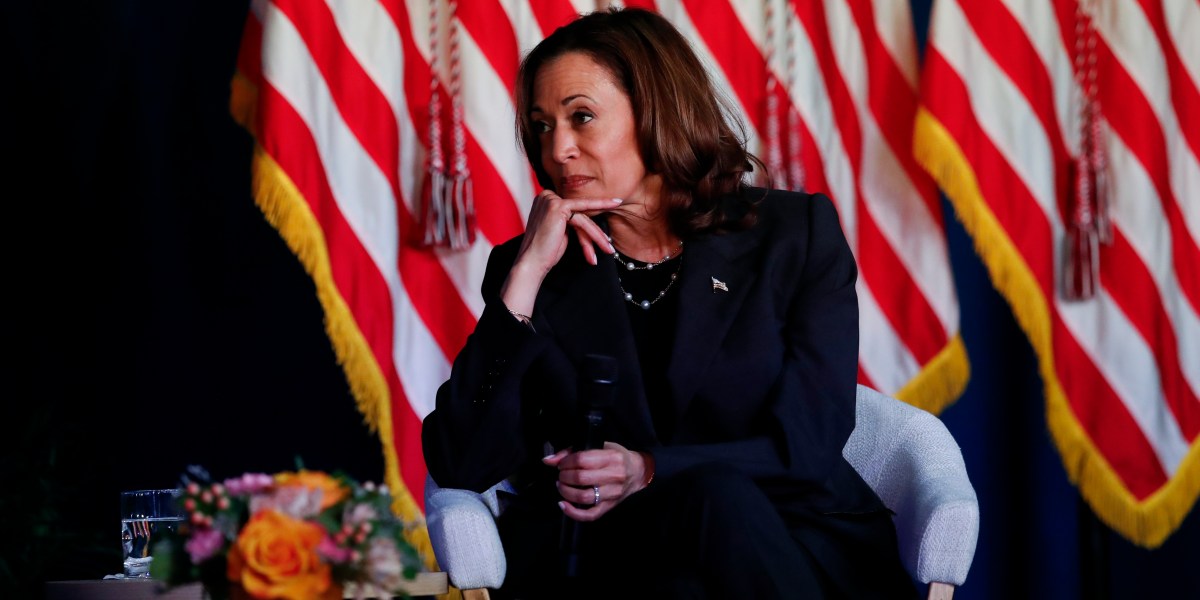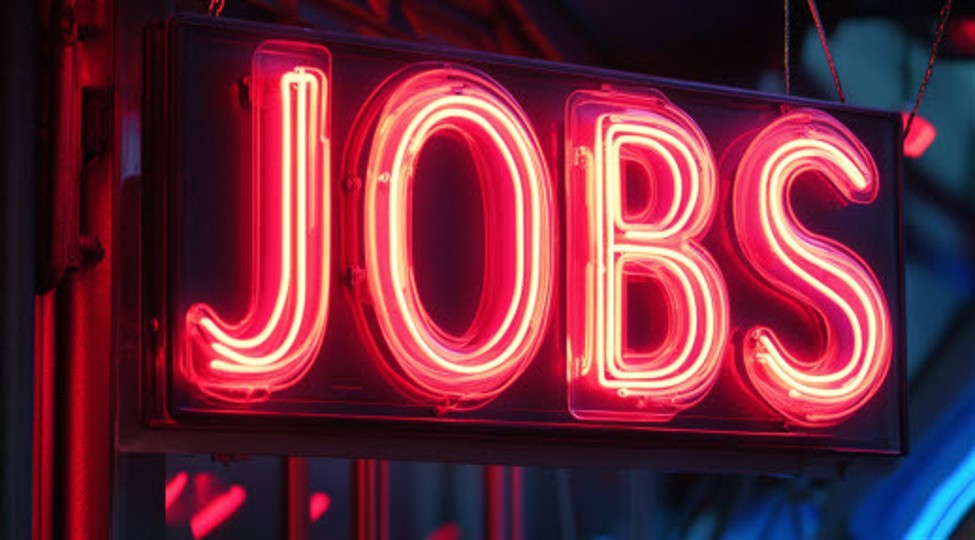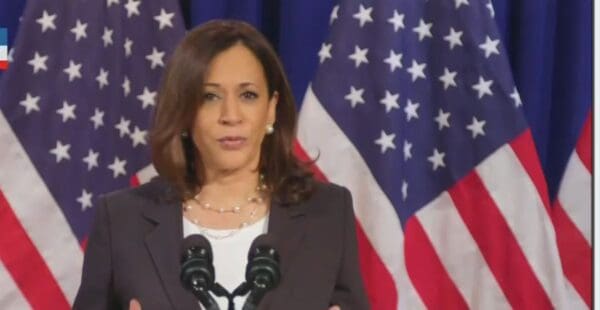Writing in the journal Public Opinion 1951, Yale researchers Carl Hovland and Walter Weiss labeled their postwar studies on the trick of persuasive messaging regardless of the truth as “the sleeper effect.” They found that a message lingers through repetition, even if factually unfounded.
Now just days away from the historic debate between Vice President Kamala Harris and former President Donald Trump, the Harris debate prep must consider how to counter the tidal wave of misinformation at this first meeting between these two leaders. And how to respond when Trump falsely claims, as he just did in Michigan again, “Over the past four years, Kamala and crooked Joe Biden have presided over an economic reign of terror, committing one financial atrocity after another. As Vice President, Kamala cast the deciding votes that caused the worst inflation in American history. You’re all victims of it. We all are.”
Surely, Harris’s advisors believe the wisdom of our first president, George Washington, who in 1799 famously suggested that the best defense is a good offense. Harris has that offensive prep down cold. She speaks with eloquence about issues like abortion rights, public health, gun safety, family safety net, and the rule of law, on which Trump is most vulnerable. Of tragic irony, after triggering massive violence, assaults on police, and 74 failed court cases, Trump has now admitted that he actually lost the 2020 election.
However, Harris does need to protect her flank from economic falsehoods which have been repeated so often that even centrist media and Democratic loyalists improperly fear them. As Trump bellows to crowds, “Are you better off economically than you were four years ago?”, the answer should be a loud YES! Here are the facts about the economy and immigration the Harris-Walz campaign must master proudly rather than be sheepishly defensive or diversionary.
Immigration
In the June debate against Biden, Trump said, “We had the safest border in history in that final couple of months of my presidency.” Trump then doubled down on his border record at the Republican National Convention saying, “Under my presidency, we had the most secure border and best economy in the history of our country.”
Trump did not have the safest or most secure border—even in recent history—and U.S.-Mexico border crossings are no longer as dire as Trump may lead voters to believe.


Annual encounters at the U.S.-Mexico border under President Trump averaged 488,164. Under his predecessor, President Barack Obama, annual encounters averaged 408,493, more than 16% lower. Even in those “final couple of months” of Trump’s presidency, Obama had lower numbers with 43,251 in December 2016 and 31,576 in January 2017, compared to 73,994 and 78,414 for Trump. Currently, President Biden can also claim to be beating Trump with the latest figures from July 2024 at 56,408. Encounters have steadily declined after Biden-Harris took executive action to secure the border, only after Trump acolytes in Congress blocked the passage of a bipartisan border bill at the former President’s request.


Inflation and wage growth
At an August rally, Trump criticized Harris’ “radical liberal policies…[that] have caused horrific inflation,” blaming Bidenomics for the rapid rise in prices since 2020.
Such claims oversimplify the sources of inflation and insult the intelligence of voters. Blaming Harris for Bidenomics is a highly contested topic even among economists with no political motive. Inflation can be attributed to five sources, most of which could be attributed to COVID-19 and idiosyncratic supply shocks, factors no president could control.
Under Biden-Harris, inflation did spike to 9.1%, but inflation has also been wrangled down to 2.9%, near historic levels. Inflation woes were not unique to the U.S. The U.K., under Conservative leadership, saw a peak of 11.1%, while Canada and Germany faced highs of 8.1% and 8.8%, respectively.
Nor should excess government spending be attributed to Biden-Harris alone. Trump passed pandemic relief programs that injected $3.6 trillion into the economy, compared to Biden-Harris at $1.9 trillion.
Biden-Harris should be recognized for bringing real wage growth back to working Americans after COVID-19’s devastating effects. The latest reading of real average hourly earnings increased 0.7% from July 2023 to July 2024. Real disposable personal income per capita is also up 5.1% since February 2020, immediately before COVID-19 hit. In dollars, per two studies from the Joint Economic Committees of Democrats and Republicans, income growth has outpaced price growth by $3,776 since 2021 (peak inflation was June 2022).
Fiscal debt
Trump claimed in the June debate: “The country was growing like never before, and we were ready to start paying down debt.”
On an equivalent basis, as debt accumulated per year in office, Trump saddled America with more debt than any president in U.S. history. Controlling for the effects from COVID-19, Biden-Harris still outperformed Trump.
Gross new borrowing under Trump amounted to $8.8 trillion, or $5.2 trillion excluding pandemic relief, compared to Biden-Harris at $6.2 trillion and $4.3 trillion for the same respective categories, as of June 2024. Extrapolating the $4.3 trillion figure through the end of the Biden-Harris term places their borrowing below that of Trump’s.
Fiscal deficit
Again, in the June debate, Trump said, “But [Biden’s] got the largest deficit in the history of our country.”
Trump oversaw the largest spending deficit in any year since World War II. Full-term net spending increases under Trump were also greater than Biden-Harris, with or without pandemic relief.
The last full fiscal year in office for Trump outspent revenues by $3.1 trillion (14.7% of GDP). Trump’s gross net spending increases, including interest, were $5.9 trillion, or $2.8 trillion without pandemic relief, compared to Biden-Harris at $4.3 trillion, or $2.3 trillion without pandemic relief. Trump’s 2017 Tax Cuts and Jobs Act is estimated to add $2 trillion to the budget deficit from FY2018-2028. Biden-Harris passed $1.9 trillion in deficit reductions, while Trump can claim only $0.4 trillion.
The Penn Wharton Budget Model recently estimated Trump’s economic proposals would increase primary deficits by $5.8 trillion over the next decade, while the full Harris plan would reduce primary deficits by $1.7 trillion.
Infrastructure
“Dollars that are sitting [in the Inflation Reduction Act] not yet spent, we will redirect that money for important projects like roads, bridges, dams,” Trump stated at the 2024 Republican National Convention.
Trump made similar promises to invest in infrastructure during his 2016 primary campaign against Hilary Clinton promising to spend more than $500 billion. He never delivered. The Biden-Harris administration has—at historic levels.
Biden-Harris’ Bipartisan Infrastructure Law and Inflation Reduction Act dedicated more than $700 billion to strengthen and modernize U.S. infrastructure. The administration has announced nearly $454 billion in funding to more than 56,000 projects and awards across the country. Projects include over 165,000 miles of roads, 9,400 bridges, 450 ports and waterways, and 300 airport terminals, among many others.
Employment
In August, Trump posted on his Truth Social platform: “Most new jobs under Biden went to illegal Immigrants. Additionally, he got what is known as Covid Bounce-back jobs…He did terribly on jobs.”


Controlling for COVID-19 complexities, Biden-Harris still saw more employment gains than Trump by a wide margin, with jobs going to both native-born and foreign-born workers.
The Washington Post recently analyzed Trump and Biden-Harris job creation, controlling for COVID-19 by measuring performance in the middle two years of their terms. Otherwise, Trump could be credited for losing 2.7 million jobs, and Biden-Harris adding 15.8 million. Under Trump, 4.4 million jobs were added, compared to Biden-Harris with 7.4 million. Both Trump and Biden-Harris have seen the rate of unemployment remain resilient at historically low levels. The Biden-Harris performance also includes unemployment of Black workers reaching an all-time low. Federal Reserve data shows over half of all changes in employment levels went to native-born workers under Biden-Harris.
Manufacturing employment
In a recent Meet the Press interview, Senator JD Vance claimed Trump brought more manufacturing jobs back to America, while Biden-Harris did not.
The Trump presidency saw manufacturing jobs decline, largely due to COVID-19, but even controlling for the pandemic, Biden-Harris still outperformed Trump.
Approximately 172,000 manufacturing jobs were lost under the full Trump Administration, compared to 765,000 manufacturing jobs added so far under Biden-Harris. Controlling for COVID-19, the middle two years of Trump’s presidency gained 237,000 manufacturing jobs, while Biden-Harris saw 358,000.
Innovation and technology
After his recent Silicon Valley campaign fundraiser, Trump bragged, “One of the primary reasons for the endorsement was the four years that we had in office, which was the best four years ever for high tech…especially as it relates to AI and all of the other new and brilliant technologies coming right at this moment.”
Trump touts his efforts to promote technical innovation and loudly complains about the need for America to recapture its competitive edge in advanced manufacturing against partners such as Taiwan. Biden-Harris did less talking—and acted by passing the CHIPS and Inflation Reduction Acts.
Notable accomplishments highlighted by Trump to “ensure American leadership in technology and innovation” include naming national research and development priorities, investing small sums for high-tech research institutes, and promoting the deployment of broadband internet. Little was done to incentivize domestic chip production, contributing to the major chip shortages during the pandemic.
Meanwhile, Biden-Harris dedicated $280 billion from the CHIPS Act and $500 billion from the Inflation Reduction Act to fund domestic chip production, expand the advanced economy, and catalyze innovation. Much of that money is already benefiting businesses and workers, such as directing $40 billion to actually connect households to broadband, infusing half a billion dollars into a dozen regional tech hubs, and galvanizing nearly $400 billion in private capital for semiconductor investment. As a result, the Semiconductor Industry Association predicts U.S. manufacturing of the world’s advanced logic chips will significantly increase over a 10-year period, from 0% in 2022 to 28% in 2032.
Biden-Harris have also acted to restrict the transfer of sensitive technologies to competitors without unduly impeding global free trade through their “small yard, high fence” philosophy. Trump took an alternative approach, often undermining his own administration’s efforts to limit tech transfers through a questionable blend of national security and personal motives.
Energy
“I will declare a national emergency to allow us to dramatically increase energy production, generation, and supply, which Comrade Kamala has destroyed,” Trump exclaimed at a recent Michigan campaign rally.


Oil and natural gas production under Biden-Harris has far exceeded Trump’s record. The Biden-Harris success also extends to renewable energy production, with renewable outpacing coal and nuclear production in 2022 for the first time.
Under Biden-Harris, the U.S. is producing around record rates of 13.4 million barrels per day of oil as the world’s single largest producer, 30% more than major producers such as Russia and Saudi Arabia, and 1 million barrels more than the previous record of 12.3 million under Trump.
Similarly, Biden-Harris have seen record natural gas production rates of 125 billion cubic feet per day, far higher than under Trump, and record renewable energy production of 912 million megawatt-hours, compared to 783 million under Trump. Biden-Harris have even issued 50% more permits for oil and gas drilling on federal lands than under Trump.
Real GDP
In his acceptance speech at the 2024 Republican National Convention, Trump claimed, “Just a few short years ago under my presidency, we had the most secure border and the best economy in the history of our country, in the history of the world.”
Controlling for COVID-19, Trump did see a strong economy, but the Biden-Harris administration has overseen a slightly stronger one. Moreover, Biden-Harris can claim to have the strongest economy in the world right now.


Annualized real GDP growth over the full Trump term was 1.7%, compared to Biden-Harris at 2.5%, as of June 2024. Looking at the first three years of each president’s term to control for COVID-19 (GDP returned to 2019 levels between Q4 2020 and Q1 2021), Trump realized an annualized real GDP growth rate of 2.58%, while Biden-Harris can claim a rate of 2.59%.
Signaling the strength of the U.S. economy, the World Bank revised its latest global growth outlook upwards by 0.2% points after stronger-than-expected growth in the U.S. accounted for 80% of the upgrade.
Global leadership
When asked about January 6 during the June debate, Trump retorted: “And let me tell you about January 6th, on January 6th…we were respected all over the world…what happened to the United States’ reputation under [Biden’s] leadership is horrible.”
As in America, Trump led the U.S. into a questionable reputation among partner and non-partner countries, while Biden has turned the numbers around despite spikes in global aggression.
International peers expressed overwhelming confidence in Biden-Harris leadership compared to Trump in the latest annual survey by Pew Research Center. The Biden-Harris responses to both the Russia-Ukraine and Hamas-Israel wars have bolstered these views. Domestically, Biden-Harris have secured bipartisan military support for each country amounting to $175 billion and $12.5 billion, respectively. Internationally, Biden-Harris have organized effective global responses to match each situation. While both volatile wars continue, they have not spread thanks to Biden-Harris interventions.
The Pew survey also found that “the share of the public that thinks the U.S. listens to countries like theirs has been on the rise” and has reached record highs in 12 countries. Since 2020, Biden-Harris have powered a significant increase in the share of countries who view the U.S. as the leading economic power, with the World Bank now proclaiming U.S. economic strength is powering 80% of their positive forecasts for 2025. Just this week, a Goldman Sachs economic forecast projected GDP growth under Harris and not under Trump.
Trump somehow discovered the “sleeper effect” without going to Yale. Harris and Walz’s advisors need to wake up to the sleeper effect too.
More must-read commentary published by Fortune:
The opinions expressed in Fortune.com commentary pieces are solely the views of their authors and do not necessarily reflect the opinions and beliefs of Fortune.















